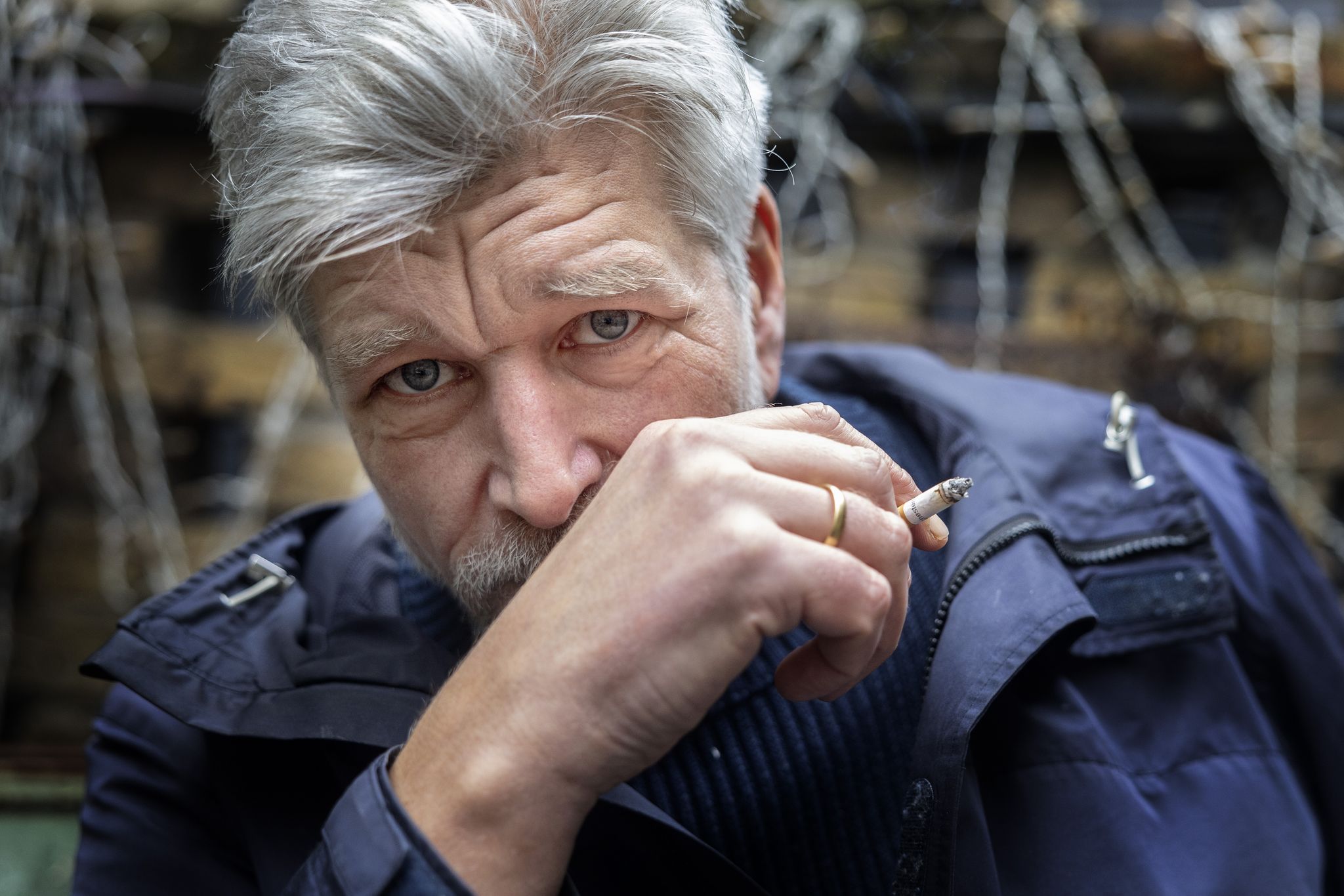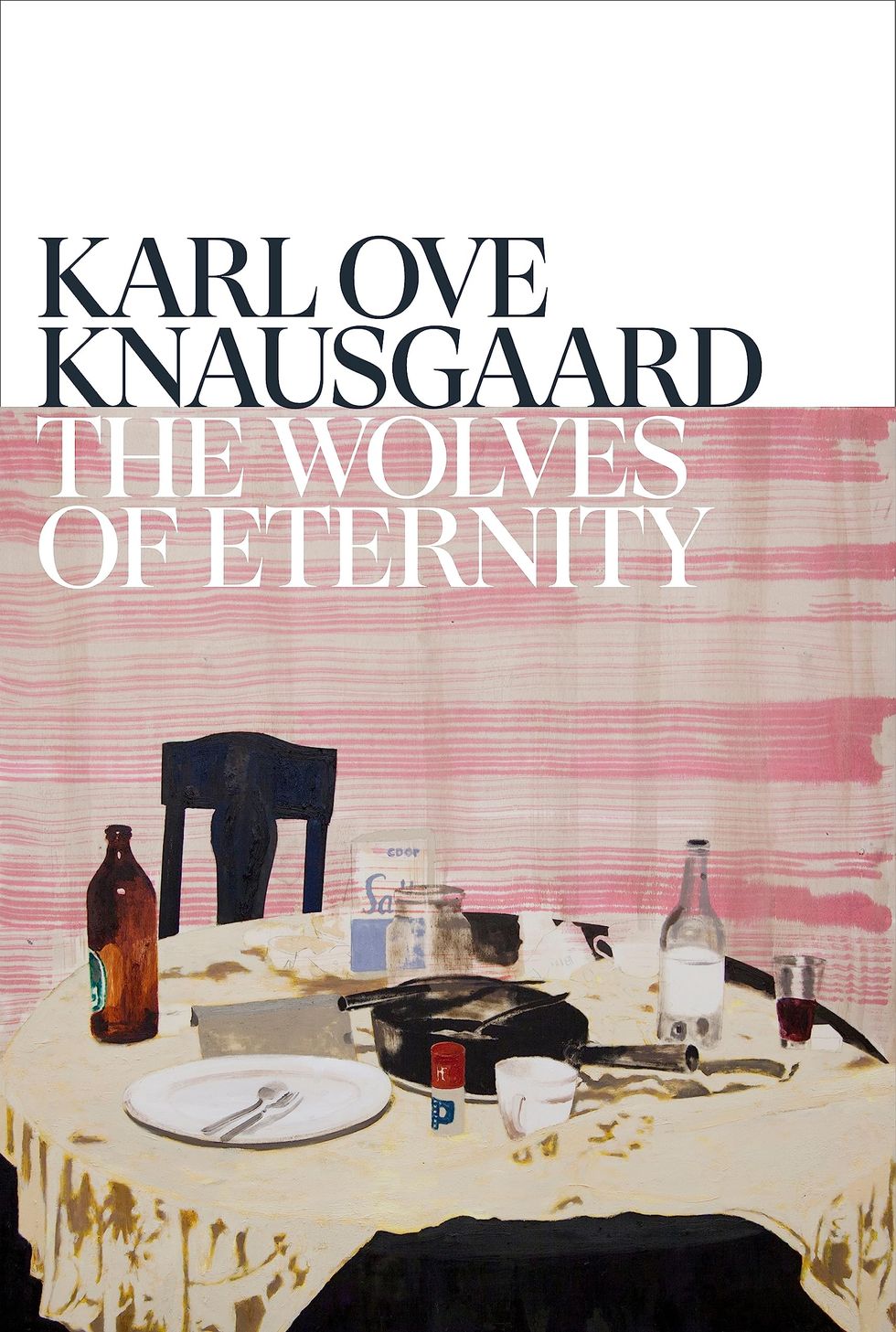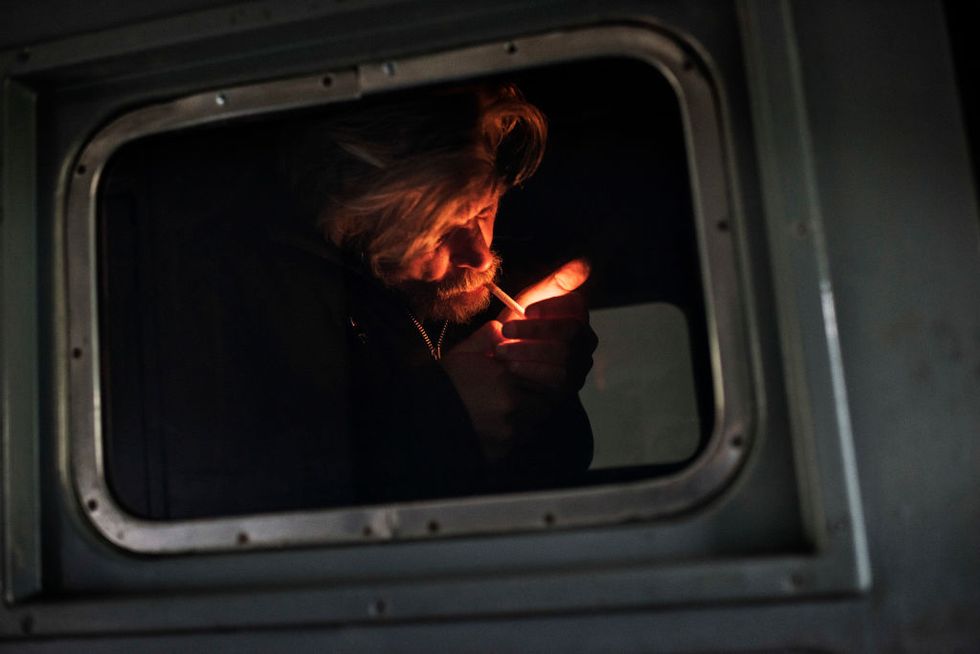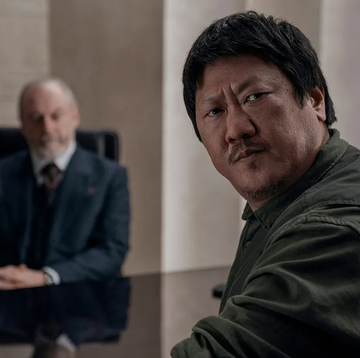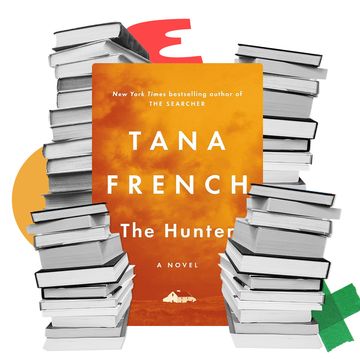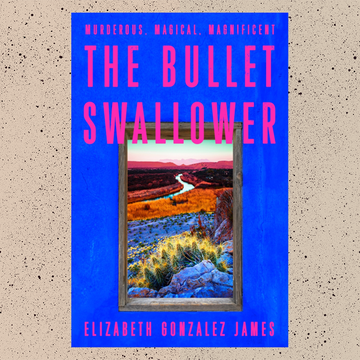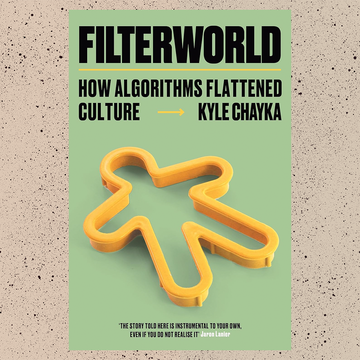To talk to Karl Ove Knausgaard, I got up at 3:30 in the morning. I hadn’t really slept the night before. We were staying with friends in Brooklyn; Knausgaard was in London. But it wasn’t only the time difference. I had no childcare, so I needed to talk before the kids woke up. The night before, I’d slept on an air mattress in the sticky mid-August heat with my nine-year-old, who gets scared in new places and could only sleep while clutching my hand.
We were meant to Zoom at 4:30 AM, but I was nervous. It was 9:30 AM in London. I boiled water for the French press. Karl Ove drinks coffee, I thought. Lots of people drink coffee, but I’d spent both last summer and this one thinking almost constantly about what Karl Ove Knausgaard thinks and likes and does. He seems to have a real appreciation for “Coke and crisps,” and he drank a Coke while we talked on Zoom. He also sucked on an e-cigarette (I know from his writing that he's tried off and on to quit smoking). It felt absurd to ask about these things, so I did not.
Karl Ove Knausgaard is 54. Norwegian. He has five children, the youngest with his third wife, with whom he lives in London. Known best for the My Struggle books, he’s written 13 more; his latest, The Wolves of Eternity, hits shelves on 5 October. Much of his work hews tightly to his own life.
Made up of six books in total, the My Struggle series begins with Knausgaard's father’s death; the second focuses largely on his daily life as a father to young children, as a writer and a partner. Three dives deep into his childhood. The books were written quickly, one after the other; they dance right up to and then explore Knausgaard's family’s responses to their appearances inside the books. The critical response was both ecstatic and complex. The series was hailed as a masterpiece. People—including Knausgaard's family members—questioned how closely and explicitly he mined his own life.
Last summer, I read the series all in a row with a good friend of mine. Both of us became wholly, obsessively enmeshed. We’d text each other constantly. “Karl Ove likes apples!” my friend said (my friend loves apples). My friend is also a writer, and we talked too about the way Knausgaard elasticises and expands time—the careful, exacting attention he gives to every scene. Riveted even when we weren’t, I craved the books when I was not inside them, and luxuriated in the scenes he built when I was.
It took me a long time to read Knausgaard. (The first of the My Struggle books came out in English in 2012). This big, hulking, handsome man who wrote these big, hulking books about himself? I had more respect for myself than that. But I started Book One and then couldn’t stop. Even now, I could still tell you the places I was sitting, standing, the feel of the air when I either read or listened to certain things he wrote. There is a rendering of a child’s birthday party in book two of My Struggle—the weird parental choreography, Knausgaard hiding in the kitchen, his daughter somehow leaving her shoes behind—that I still think about all the time. Knausgaard is deeply engaged with lots of big abstract ideas, not least life and death, philosophy, Hitler, and Kierkegaard, but when I recommend the books, I often point out how brilliant he is at rendering the domestic: modern parenthood, the strife and joy of the mundane.
At 4:30 AM, on Zoom, Knausgaard and I talked for an hour. At 5:15, my friend’s toddler started to cry, and it came through the baby monitor. There’s a whole page on the transcription of our conversation that says only, Speaker 3: Mummy, Speaker 3: Mummy, over and over down the whole page.
Knausgaard was kind and warm, and almost painfully deliberate. He paused for long periods between questions, and my skin would prickle with panic each time. Had I said anything, really? Did Karl Ove Knausgaard think I was an idiot? Once we signed off, I sent the recording off for transcription and then proceeded not to look at it for weeks.
Knausgaard published his first novel, Out of the World, at 27. “It was like hitting gold, because it was a moment of writing and being selfless,” he told me. “That was the clue. You just disappear into your writing, and I knew then, ‘This is good.’ Because it was just to write and it wasn’t about thinking or anything. It was almost the opposite of thinking—just following the text, following whatever comes up.”
Something Knausgaard seems to believe above all things, when it comes to writing, is that “you have to get inside the text… if it feels separate, if you see it from the outside, you collide with it. It doesn’t work.” When he starts a novel, his way of getting into it is “to know almost nothing.” He continued, “I've never done meditation, never been into religion in any way, but it's a feeling that you're connected, somehow, to the writing.”
After that first novel, it took him five years to write the next. Voices from the outside overwhelmed him. After his second book, A Time For Everything, he spent another five years in agony working on the first volume of My Struggle. “That was just an act of desperation,” he told me. “I didn't know what to do. I forced myself to write a certain amount of pages every day, which helps a lot if the problem is self-awareness and self-criticism, because you can't afford it. You just have to write it and you have to accept it, because it is all about acceptance. I have manuscripts from my old days, like eight hundred pages of beginnings. Never good enough to continue. To me, it's all about acceptance.”
The My Struggle novels, while wholly engaged with the actual events of Knausgaard's life, did not begin for Knausgaard as an examination of the self, but rather as a way to skip past or through that self-criticism. As he wrote, he thought it was “idiosyncratic, unreadable,” but forced himself to just keep going. It was a way to trick himself into that acceptance.
“So then I did My Struggle,” Knausgaard told me. “I was meant to do Volume Six within a year, and, when it was six, it was all performance. I knew what people liked and what they disliked, and once you know that, then you’re outside of it. Then it’s not real, it’s not good, it’s not there. Then I took another year… I had to forget myself.”
Every time I thought about writing this piece, the idea of writing about Karl Ove Knausgaard would collide with (and then render silly and absurd) whatever I might think to say. He’s said everything there is to say, and better than I could. He’s been written about so much. I have too many mushy, awkward, complicated feelings about the work. I had nothing new to say. The time I had to write the piece started to tick down to nothing. I became, slowly, desperate.
Knausgaard has been compared to Marcel Proust for the way he moves capaciously through time; the careful, acute attention he pays to the life that lives inside of the mundane. He has a masterful sense of the elasticity and utility of movement within a fictional space. When I asked him about this, he said his three key texts (his answer to almost every question involves another text, a work of art, a film) are Proust, James Joyce’s Ulysses (“though I’m not sure if I like it, really,” he says), and Virginia Woolf’s To The Lighthouse. “That’s why I called the My Struggle books fiction,” he said, “because they deal with time the way only fiction can.”
His newest book, The Wolves of Eternity, is a follow-up to The Morning Star, which was published in English in 2020. The third volume in this series is already written, but not yet available in translation. Knausgaard is currently working on the fourth volume. Wolves has two main point of view characters: Syvert, a Norwegian teenager we meet in 1986 who grows up over the course of the book, and Alevtina, a Russian biology professor, who is Syvert’s half-sister in what is close to our present day. The Morning Star, by contrast, has nine point of view characters, none of whom are Knausgaard—though tidbits from his earlier books are recognisable in all of them—and takes place over a couple of days. Both have some surreal, mystical elements, and both engage with the violence and the mystery of the natural world. They are a return to a more fictional relationship to fiction. But then again, all writing is construction. “It’s always building something artificial,” Knausgaard said.
Knausgaard started writing The Wolves of Eternity right after finishing the last of the My Struggle books, though he didn’t know it then. “I wrote about thirty pages, but thought ‘this is crap,’” he said. “I didn’t even show it to my editor, who reads everything I write. I put it away.” But then, months later, he got it back out. “I thought ‘wow,’ this is so different than anything I’ve done before,” he told me. (Later, his editor would point out all the ways that Syvert, too, is very Knausgaard-like) “He’s so upbeat,” Knausgaard said, laughing. “It was sort of joyful to write about someone who doesn’t reflect much. Someone who’s very social, put into a deeply existential situation that he has to handle without really thinking.”
Syvert has just returned from his military service and is adrift. His mother has recently been diagnosed with cancer. He is tasked with looking after his younger brother while she goes to a hospital a few towns away for surgery; while at home, Syvert discovers letters from his father’s lover (Alevtina’s mother), whom Syvert’s father was planning to leave Syvert’s mother for before he died.
Knausgaard continued, “The whole Wolf book is really about two things that I wanted. I knew I wanted to go to Russia, and I knew it had to be about the dream of being immortal. So the whole first part is just trying to bend from Norway to get to Russia. And I didn’t know what I would find there.”
He then tells a story straight out of a Knausgaard book, set at a bookshop in London with his son. “I have like three minutes before my son gets impatient, so I just go to the philosophy department and grab some books and bring them home,” he recalled. That day, he found a book called The Future of Immortality: Remaking Life and Death in Contemporary, by the writer Anya Bernstein. In it, there’s a recounting of Russians protesting death and aging; Knausgaard thought, “I want to look at that.” Immortality, Knausgaard told me later, sounds to him like “the worst kind of hell.”
“Really, Wolves is about the feeling of being locked into a world which is defined,” he said. “So when I look around, almost everything is about defining things, defining phenomenons, defining everything that happens. Everything you read is about defining the world. Writing is transgressive. I mean, in its nature, it's transgressive, and it's also the possibility to see things from different angles.”
Knausgaard believes that our contemporary way of being is too stagnant—designed, he said, to avoid any possibility for change. “Maybe especially with the technology we have now, because it's about preserving,” he mused. “Photography is about preserving. Audio is about preserving. Records are about preserving. Computers are about preserving. It’s an algorithm which is a recipe, and something comes out. But it's decided. It's decided, it's decided, and it belongs in the past. It isn't evolving. I wanted a transgressive thing. I wanted a disturbance between these things we know and the things that are established.”
In both books, there is a new, inexplicable star in the sky. It will have shocking, mysterious effects on the whole world. Late in Wolves, Syvert’s wife emails him about the way the world and the news are responding to it, trying immediately to define it, to conscript it into a box. “Why is it so impossible for anyone to accept that something might be new?” she asks. It was one of those Knausgaard moments that stopped me in my tracks.
Here's a thing I hear in my head a lot when I’m writing: blah blah blah, shut up you idiot! I hear a quick swipe some asshole might make at me on Twitter. I hear an editor feeling exhausted, overwhelmed by all the extraneous stuff I couldn’t help but add, by my total inability to just do what was asked. Everything I write starts to sound boring. Too much about my children. Too much about myself. The shame alights and I have to close my computer. I feel like I might vomit. I run many, many miles. (Knausgaard talks about art, in another book, as “a restlessness born of longing”; this is a phrase I think about almost every day.)
Shame is one of Knausgaard's projects—slipping past or outside of the self and into a register of a different self, not aware enough to recognize that at some point he’ll be looked at, examined, swiped at. It’s the only way, he told me, to touch the truth the shame holds inside of it up close. It’s the only way to make the life one needs to make inside the thing that one is making. Instead of capturing something from the outside, he said (that would be a sort of preservation, presentation), it is the writer’s job to build the life of a work of art from the inside out.
“What is really boring,” he said. He spoke earlier, laughingly, about his work being boring. The books are long and exacting. You spend pages with Syvert thinking about how to pay his bus fare; pages of Syvert thinking about when and how to turn on his phone once he gets to Russia and exits his plane. About this, Knausgaard said, he has no choice but to give those mundane moments to you: “Because you’re seeing the world from a specific place, because you can’t see it from anywhere else.” There were other times he used the word “boring” pejoratively, but here, it felt like he was proud of it.
The boring that he seems to most abhor is the boring that comes from writing as if you know exactly what you’re doing, as if there is no mystery. “What really makes the writing boring is to present something in writing,” he said. “So if you know something and you present it, then nothing happened, and then it's kind of lifeless. So it's all about being at the point where you don’t really know… You can’t just put a form onto a subject. It has to become. And that goes for everything I believe in, really. It’s that knowledge somehow stops. It ends. And then it moves to the self and living.”
The day this piece was due, I finally got up at 4:30 and sat down to write it. The transcription was a wreck, so instead I had to watch the Zoom over and over to correct it. I had to skip the parts of me talking, my insane gestures, my worn-out face. I tried just to listen to Knausgaard, presence, presence, presence, and then to write about him. I shut the shame up as best I could and tried to pour myself in, too. I didn’t look at any of the reams of notes I’d taken the whole summer. My kids got up, and I had to make their breakfasts and their lunches. Knausgaard says he does not think about the work when he’s not inside of it—“I have a life where literature is not the most important thing, where I am not the most important thing. So I leave it.”—but I was hardly present at all as I walked my younger kid to school.
We were talking about birthdays—my older daughter was about to turn eleven—and all their cousins and their differences and similarities. My younger kid’s non-binary and was wearing a dress that day. I told them their only male cousin is the one with the birthday closest to theirs. “That’s interesting,” my kid said. Their dress was pink, with yellow bows at the shoulders; they have big blue eyes, hair shorn close to their head. “And we’re also the only ones who aren’t girls,” they said. I thought then again about Knausgaard, about all the spaces of not knowing that we refuse to get inside of, about art and boundaries and transgression, disturbing the things we think are established, about how the only place to see the world, to glimpse its mysteries, to make work that might be built through a process of becoming, is from being surely, solidly, but also searchingly, inside the place you are.
Lynn Steger Strong is the author of the novels Hold Still, Want, and Flight. She teaches writing at Princeton and Columbia Universities.
